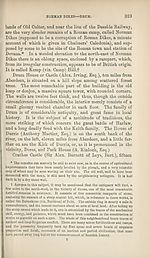Download files
Complete book:
Individual page:
Thumbnail gallery: Grid view | List view

324
ABERDEEN TO BALDATER, ETC.
miles from Aberdeen on the right, looks forth from a sloping
mass of thick woodland. It is one of those old Flemish build¬
ings which, rising as it were from solid root and stem, becomes,
as it ascends, broken into a varied picturesque cluster of turrets,
chimneys, and peaked gables. There are, unfortunately, some
modem additions sadly out of keeping with the picturesque
character of the older part. Here, as at Drum, there is abun¬
dant traditionary lore, both in prose and song.
Eighteen miles from Aberdeen, at the termination of the
Deeside line, is the village of Banchory Teman, or
Upper Banchory.
[Inn: The Burnett Arms.]
A new Gothic church, in good taste, terminates the steep bank
of the river, along which the straggling village runs. The Dee
is here joined by the Feugh,* an angry moss-stained stream,
which comes thundering down from the mountains. Near its
junction it crosses a stony barrier, where, after a succession of
broken foaming torrents and inky pools, it casts itself over the
brow of a rock, and makes a stormy cascade—its last act of
independent turbulence, before its troublesome spirit is subdued
by intermixture with the more dignified and placid waters of
the Dee. Looking up in the direction whence this stream
runs, the traveller will see the broken outline of the hills
from which its waters are supplied, and towering above the
others is the characteristic summit of Cloch-na-ben, with a
great stone like a gigantic wart projecting from its brow.
Four miles north from Banchory is the Hill of Fare, wide
and flat and not very elevated, presenting little attraction to
the searcher after the romantic. A hollow on the south side,_
* If the course of the Feugh is followed upwards, the traveller will find, after
passing the picturesque villas of “ Feugh Cottage,” and “ Inverey House,” the
water subsiding into a gentle stream, abounding in trout and occasionally salmon. :
Four miles westward are the church and village of Strachan, and beyond Strachan ]
the valley expands into a wide and well cultivated district—the Feugh here receiv¬
ing the water of Avon, also noted for its fishing, as a tributary stream. At the
western extremity of this valley, finely situated and commanding an extensive pros- :
pect of it and of the Grampians, is the ancient mansion of Farquharson of Finzean, l
a family who have held the property for several centuries. The house and extensive'*,
woodlands adjoining have been greatly improved by the present proprietor (Francis
Farquharson, Esq.)
ABERDEEN TO BALDATER, ETC.
miles from Aberdeen on the right, looks forth from a sloping
mass of thick woodland. It is one of those old Flemish build¬
ings which, rising as it were from solid root and stem, becomes,
as it ascends, broken into a varied picturesque cluster of turrets,
chimneys, and peaked gables. There are, unfortunately, some
modem additions sadly out of keeping with the picturesque
character of the older part. Here, as at Drum, there is abun¬
dant traditionary lore, both in prose and song.
Eighteen miles from Aberdeen, at the termination of the
Deeside line, is the village of Banchory Teman, or
Upper Banchory.
[Inn: The Burnett Arms.]
A new Gothic church, in good taste, terminates the steep bank
of the river, along which the straggling village runs. The Dee
is here joined by the Feugh,* an angry moss-stained stream,
which comes thundering down from the mountains. Near its
junction it crosses a stony barrier, where, after a succession of
broken foaming torrents and inky pools, it casts itself over the
brow of a rock, and makes a stormy cascade—its last act of
independent turbulence, before its troublesome spirit is subdued
by intermixture with the more dignified and placid waters of
the Dee. Looking up in the direction whence this stream
runs, the traveller will see the broken outline of the hills
from which its waters are supplied, and towering above the
others is the characteristic summit of Cloch-na-ben, with a
great stone like a gigantic wart projecting from its brow.
Four miles north from Banchory is the Hill of Fare, wide
and flat and not very elevated, presenting little attraction to
the searcher after the romantic. A hollow on the south side,_
* If the course of the Feugh is followed upwards, the traveller will find, after
passing the picturesque villas of “ Feugh Cottage,” and “ Inverey House,” the
water subsiding into a gentle stream, abounding in trout and occasionally salmon. :
Four miles westward are the church and village of Strachan, and beyond Strachan ]
the valley expands into a wide and well cultivated district—the Feugh here receiv¬
ing the water of Avon, also noted for its fishing, as a tributary stream. At the
western extremity of this valley, finely situated and commanding an extensive pros- :
pect of it and of the Grampians, is the ancient mansion of Farquharson of Finzean, l
a family who have held the property for several centuries. The house and extensive'*,
woodlands adjoining have been greatly improved by the present proprietor (Francis
Farquharson, Esq.)
Set display mode to:
![]() Universal Viewer |
Universal Viewer | ![]() Mirador |
Large image | Transcription
Mirador |
Large image | Transcription
| Antiquarian books of Scotland > Scotland/Scots > Black's picturesque tourist of Scotland > (420) |
|---|
| Permanent URL | https://digital.nls.uk/130033230 |
|---|
| Description | Thousands of printed books from the Antiquarian Books of Scotland collection which dates from 1641 to the 1980s. The collection consists of 14,800 books which were published in Scotland or have a Scottish connection, e.g. through the author, printer or owner. Subjects covered include sport, education, diseases, adventure, occupations, Jacobites, politics and religion. Among the 29 languages represented are English, Gaelic, Italian, French, Russian and Swedish. |
|---|

